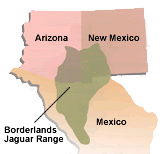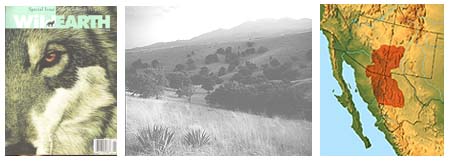|
The Wildlands Project Comes to Hidalgo County (Part 14) A Country Girl’s Musin’
By Judy Keeler Some of my readers may have found my last two articles a little overwhelming. Initially, I found the claims of the United Nation’s involvement in the environmental movement more than a little questionable. I continued my research anyway. It was by attending the Arizona and New Mexico Jaguar Conservation Team meetings that I learned of the ties to the United Nations. Let’s look at the history of this species in the Southwest. Wildlife biologists have known for years that jaguars range in and out of our states. According to the historical records, Arizona has experienced 16 confirmed sightings over the past 150 years, New Mexico, only 7. A jaguar was photographed by Warner Glenn in 1996. It created quite a stir. When another sighting occurred in the Baboquivari Mountains south of Tucson the excitement grew. Articles on the sightings began to appear in both Arizona and New Mexico newspapers. After Warner Glenn published his book, “Eyes of Fire”, reporters began calling local residents to get their comments. Articles were published in the Wall Street Journal, New York Times and at least one Japanese newspaper. Much to the chagrin of the ranchers and hunters, they were often portrayed as the villains. We learned later The Nature Conservancy orchestrated much of the national media blitz.
These sighting, however, became more than just newsworthy when federal and state wildlife agencies and various environmental organizations jumped on the bandwagon! Debate soon began as to whether the species should be listed as endangered in the United States, or whether a conservation agreement between the states should be developed to conserve the species. During the frenzy it became obvious pressure was being applied to the ranching community to support the CA. Ultimately, however, we ended up with both the federal listing of the species as endangered and the conservation agreement. Eleven (11) federal and state agencies signed on to The Memorandum of Agreement for the Conservation Assessment and Strategy. The Conservation Team did, however, enlist a group of scientists to be a part of their Scientific Advisory Group (SAG). The leading scientist on the Group, Alan Rabinowitz, is a world renowned jaguar specialist and director of Science for the Wildlife Conservation Society’s International Programs at the Bronx Zoo in New York City. Dr. Rabinowitz helped establish the first-ever jaguar reserve in Belize’s Cockscomb Basin. Working with the Belize government, Dr. Rabinowitz relocated an entire community from within the boundaries of the reserve in order to conserve the species. In a report to the Malpai Borderlands Group, Dr. Rabinowitz wrote,
"the fact that the southwestern United States is the northern
limit of the modern jaguar's range is not by chance. The more open,
dry habitats of the southwest are marginal for the jaguar in terms
of water, cover and prey densities. The nature of this landscape,
ranging from open grassland/shrub communities to mountain woodlands,
is a product of both past climatic influences dating back to the Pleistocene,
and to the relatively recent human activities and settlement patterns
in the area." Most of the Conservation Team agreed with his findings and suggested scientific research should begin in Mexico where several breeding pairs of jaguars were thought to exist. It was during our discussions on where to begin research activities that Terry Johnson, Chief of the Non-Game Branch of the Arizona Game and Fish Department, suggested the Team focus on Mexico by inviting ranchers and wildlife biologists to participate in the Conservation Assessment. Some members questioned by what authority the Team could expand the Assessment and Strategy into Mexico. Mr. Johnson suggested by treaties signed between the two nations. When pressed for which treaties, he supplied the Team with a “Memorandum of Understanding (MOU) establishing the Canada/Mexico/United States Trilateral Committee for Wildlife and Ecosystem Conservation and Management”. The committee consists of the U.S. Fish and Wildlife Service and its counterparts in Mexico and Canada. According to the MOU, it was the Committee’s desire to “facilitate the conservation of species and the ecosystems on which they depend”. The three nations entered as “Parties” to the various Treaties and Conventions providing cooperation in the Spring of 1996. Seven Treaties were specifically mentioned in the MOU, including the 1992 Convention on Biological Diversity, which had never been ratified by the U.S. Congress. And, the 1993 North American Agreement on Environmental Cooperation, a side agreement to NAFTA. It should be noted that Terry Johnson started his career with Arizona Game and Fish when the Heritage Data Base was transferred to the states by The Nature Conservancy. Prior to the transfer, he was employed by the Conservancy. Working his way up through the state agency, Mr. Johnson has been instrumental in the reintroduction of the Mexican Wolf into the U.S. and the Conservation Agreement to preserve Prairie Dogs. About 3 years after its formation, representatives from various environmental groups started attending the Team meetings. Did Dr. Rabinowitz’s reports and the consensus of the Team to begin research in Mexico “enlighten” some of these representatives? No! Michael Robinson, Center for Biological Diversity, wrote an opinion piece in the Albuquerque Journal, entitled “Near-Decimated Jaguar Deserves a NM Home”. Why? Because he wants to see jaguars romping in his backyard of the Gila National Forest near his home in Pinos Altos, NM. Among other things he claimed, “Too many jaguars have already died and its range also is shrinking in Mexico. It is time to listen to the scientists, protect jaguar habitat, stop the poisoning and plan for a reintroduction into our still-wild canyons and forest that were the traditional home to big-spotted cats”. Although another photograph of a jaguar was taken by a trip camera in southern Arizona December 2001, one can hardly claim we have an abundance of sightings. In fact, most sighting reports turn out to be large, black house cats. Every 6 months the Team meets to review the “sightings reports”, “kill verifications”, and “legal protection” which have changed very little since the conception of the Team. The “education” portion of the Conservation Assessment has degenerated into a curriculum that teaches students what a jaguar looks like, his characteristics as well as his prey base, but does little to teach critical thinking skills, or expose students to some of the controversy surrounding the Endangered Species Act, or its ramifications, to the dismay of some of the Team members. The Team has developed, as a part of its “educational program”, a cute little brochure that asks, “Have You Seen This Animal?” with a picture of a jaguar on its front cover and numbers to call if sighted. With assistance from The Nature Conservancy, mapping potential habitat in the two states has evolved into a new map that closely resembles the Sky Island’s map of the 70,000 square mile preserve it covets in New Mexico, Arizona and Mexico. The new jaguar map stretches to the Rio Grande near Las Cruces, and north to the Gila National Forest, although there is little scientific evidence to justify the reach. With the help of the U.S. Fish and Wildlife a new term has been coined for “critical habitat” in this U.S. The Service calls it “occupied range”, which currently includes all of Hidalgo County, and “occupied habitat”, which includes the back bone of the New Mexico portion of the Peloncillo Mountains into Arizona. They’ve yet to delineate these areas in Arizona and Mexico, but give them time, they’re working on it. No doubt the map also includes a huge tract of land already planned as part of a U.N. Biosphere Reserve in the Sierra San Luis Mountains south of Agua Prieta, Mexico. In an article entitled, "The Great Green Con-Trick", Dr. Patrick Moore, renowned ecologist and founder of Greenpeace, is quoted extensively. He condemns his fellow ecologists for “abandoning science” to follow “agendas that have little to do with saving the earth, or its species”. Dr. Moore sadly reflects in the commentary, "What has been lost are the principles of the early environmental movement: that all campaigns should be based on valid research. We won public support because our protests were founded on logical, scientific arguments." He claims these campaigns have been "replaced by a policy of sensationalism, misinformation and never-ending conflict". I believe they’ve been replaced by the Wildlands Project.
Related articles: WCS Big Cat Expert Applauds Jaguar Protection – July 25, 1997 http://wcs.org/3422?newsarticle=3338 Wandering jaguar shakes things up - http://dailynews.yahoo.com/h/azstar/20020224/lo/wandering_jaguar_shakes_things_up_1.html
These articles are being published in the Hidalgo Herald, a local newspaper. If you would like a copy of the articles in this format send your request to: Hidalgo County Herald - hcherald@aznex.net Brenda McCalmon, editor Contact: Judy Keeler To read the complete set of the "Wildlands Project Comes to
Hidalgo County" articles, visit:
|

